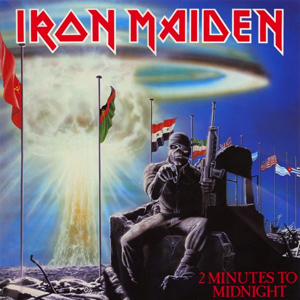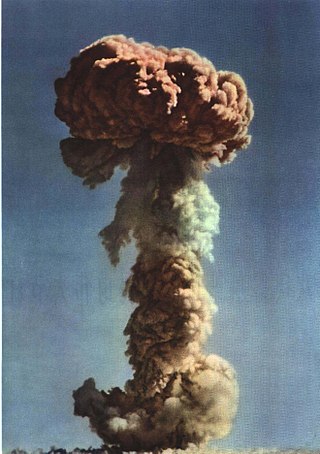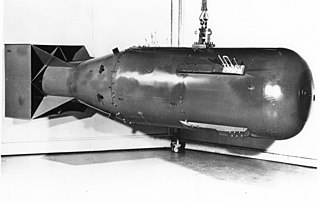
A nuclear weapon is an explosive device that derives its destructive force from nuclear reactions, either fission or a combination of fission and fusion reactions, producing a nuclear explosion. Both bomb types release large quantities of energy from relatively small amounts of matter.

Nuclear warfare, also known as atomic warfare, is a military conflict or prepared political strategy that deploys nuclear weaponry. Nuclear weapons are weapons of mass destruction; in contrast to conventional warfare, nuclear warfare can produce destruction in a much shorter time and can have a long-lasting radiological result. A major nuclear exchange would likely have long-term effects, primarily from the fallout released, and could also lead to secondary effects, such as "nuclear winter", nuclear famine, and societal collapse. A global thermonuclear war with Cold War-era stockpiles, or even with the current smaller stockpiles, may lead to various scenarios including the human extinction.

The Doomsday Clock is a symbol that represents the likelihood of a human-made global catastrophe, in the opinion of the members of the Bulletin of the Atomic Scientists. Maintained since 1947, the Clock is a metaphor, not a prediction, for threats to humanity from unchecked scientific and technological advances. That is, the time on the Clock is not to be interpreted as actual time. A hypothetical global catastrophe is represented by midnight on the Clock, with the Bulletin's opinion on how close the world is to one represented by a certain number of minutes or seconds to midnight, which is then assessed in January of each year. The main factors influencing the Clock are nuclear warfare, climate change, and artificial intelligence. The Bulletin's Science and Security Board monitors new developments in the life sciences and technology that could inflict irrevocable harm to humanity.

World War III, also known as the Third World War, is a hypothetical future global conflict subsequent to World War I (1914–1918) and World War II (1939–1945). It is widely assumed that such a war would involve all of the great powers, like its predecessors, as well as the use of nuclear weapons or other weapons of mass destruction, surpassing all prior conflicts in geographic scope, devastation and loss of life.

The Bulletin of the Atomic Scientists is a nonprofit organization concerning science and global security issues resulting from accelerating technological advances that have negative consequences for humanity. The Bulletin publishes content at both a free-access website and a bi-monthly, nontechnical academic journal. The organization has been publishing continuously since 1945, when it was founded by Albert Einstein and former Manhattan Project scientists as the Bulletin of the Atomic Scientists of Chicago immediately following the atomic bombings of Hiroshima and Nagasaki. The organization is also the keeper of the symbolic Doomsday Clock, the time of which is announced each January.
Bernard Taub Feld was a professor of physics at the Massachusetts Institute of Technology. He helped develop the atomic bomb, and later led an international movement among scientists to banish nuclear weapons.

The Soviet atomic bomb project was the classified research and development program that was authorized by Joseph Stalin in the Soviet Union to develop nuclear weapons during and after World War II.
RDS-6s was the first Soviet attempted test of a thermonuclear weapon that occurred on August 12, 1953, that detonated with a force equivalent to 400 kilotons of TNT.

"2 Minutes to Midnight" is a song by the English heavy metal band Iron Maiden, featured on their fifth studio album, Powerslave (1984). It was released as the band's tenth single, and first from the album on 6 August 1984. It rose to number 11 on the UK Singles Chart and number 25 on Billboard Top Album Tracks. The band's first single to exceed five minutes in length, it remained their longest until the release of "Infinite Dreams" in November 1989.

Project 596 was the first nuclear weapons test conducted by the People's Republic of China, detonated on 16 October 1964, at the Lop Nur test site. It was a uranium-235 implosion fission device made from weapons-grade uranium (U-235) enriched in a gaseous diffusion plant in Lanzhou.

Launch on warning (LOW), or fire on warning, is a strategy of nuclear weapon retaliation where a retaliatory strike is launched upon warning of enemy nuclear attack and while its missiles are still in the air, before detonation occurs. It gained recognition during the Cold War between the Soviet Union and the United States. With the invention of intercontinental ballistic missiles (ICBMs), launch on warning became an integral part of mutually-assured destruction (MAD) theory. US land-based missiles can reportedly be launched within 5 minutes of a presidential decision to do so and submarine-based missiles within 15 minutes.
A Walk of the People – A Pilgrimage for Life was a walking personal and political action organized by peace activists Dale James Outhouse and Pamela Blockey O'Brien to bring attention to the perils of impending nuclear war between the United States and the Soviet Union. Former European Parliament member and French Green Party co-founder Solange Fernex was the European organizer of the project.
"Manhattan Project" is a 1985 song by Canadian progressive rock band Rush, named after the WWII project that created the first atomic bomb. The song appeared on Rush's eleventh studio album Power Windows in 1985. "Manhattan Project" is the third track on the album and clocks in at 5:07. Despite not being released as a single, it did reach #10 on the U.S. Mainstream Rock Chart.

"Seven Minutes to Midnight" was the second and final single released by Pete Wylie's Wah! Heat incarnation. The band had made major line-up changes and bass guitar player Pete Younger was replaced by Colm Redmond, then Carl Washington who became Wylie's right hand. The recording included keyboard player King Bluff for the first time. It was during this incarnation that they recorded their only Peel Session on 19 May 1980. The release of the single also marked the departure of Colm Redmond and the transformation of Wylie's first outfit into the better known four piece Wah!.

A nuclear holocaust, also known as a nuclear apocalypse, nuclear annihilation, nuclear armageddon, or atomic holocaust, is a theoretical scenario where the mass detonation of nuclear weapons causes widespread destruction and radioactive fallout. Such a scenario envisages large parts of the Earth becoming uninhabitable due to the effects of nuclear warfare, potentially causing the collapse of civilization, the extinction of humanity, and/or the termination of most biological life on Earth.
This timeline of nuclear weapons development is a chronological catalog of the evolution of nuclear weapons rooting from the development of the science surrounding nuclear fission and nuclear fusion. In addition to the scientific advancements, this timeline also includes several political events relating to the development of nuclear weapons. The availability of intelligence on recent advancements in nuclear weapons of several major countries is limited because of the classification of technical knowledge of nuclear weapons development.

The renovation of the nuclear weapon arsenal of the United States is the modernization, refurbishment and rebuilding of the nuclear arsenal of the United States of America.
Two Bombs, One Satellite was a nuclear weapon, intercontinental ballistic missile (ICBM), and artificial satellite development program by the People's Republic of China. China detonated its first fission and first thermonuclear weapons in 1964 and 1967 respectively, combined a nuclear weapon with a surface-to-surface missile in 1966, and successfully launched its first satellite in 1970.









